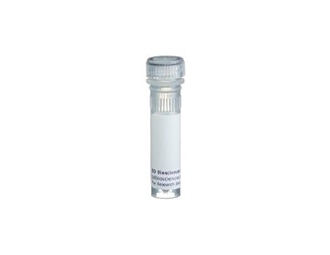Old Browser
This page has been recently translated and is available in French now.
Looks like you're visiting us from {countryName}.
Would you like to stay on the current country site or be switched to your country?




Flow cytometric analysis of CD3e expression in rat spleen and thymus. LEW splenocytes (left panels) were simultaneously stained with PE Mouse Anti-Rat CD4 (Cat. No. 554838), PE Mouse Anti-Rat CD8a (Cat. No. 559976/554857) and Biotin Mouse Anti-Rat CD3 (Cat. No. 554831, bottom left panel) monoclonal antibodies, followed by Avidin FITC (Cat. No. 554057). Please note that CD3-CD4+ monocytes and CD3-CD8a+ NK cells may be found in the rat spleen. LEW thymocytes (right panels) were stained with either Biotin Mouse IgG3, κ Isotype Control (Cat. No. 559805; top right panel) or Biotin Mouse Anti-Rat CD3 (bottom right panel), followed by Avidin FITC. The fluorescence contour plots/histograms were derived from gated events with the forward and side light-scattering characteristics of viable cells. Flow cytometry was performed on a BD FACScan™.


BD Pharmingen™ Biotin Mouse Anti-Rat CD3

Regulatory Status Legend
Any use of products other than the permitted use without the express written authorization of Becton, Dickinson and Company is strictly prohibited.
Preparation And Storage
Product Notices
- Since applications vary, each investigator should titrate the reagent to obtain optimal results.
- An isotype control should be used at the same concentration as the antibody of interest.
- Caution: Sodium azide yields highly toxic hydrazoic acid under acidic conditions. Dilute azide compounds in running water before discarding to avoid accumulation of potentially explosive deposits in plumbing.
- For fluorochrome spectra and suitable instrument settings, please refer to our Multicolor Flow Cytometry web page at www.bdbiosciences.com/colors.
- Please refer to www.bdbiosciences.com/us/s/resources for technical protocols.
Companion Products



.png?imwidth=320)
The G4.18 monoclonal antibody specifically recognizes the T-cell receptor-associated CD3 cell-surface antigen found on thymocytes, peripheral T lymphocytes, and dendritic epidermal T cells. It has been reported that CD3 expression is down-regulated within 24 hours in concanavalin A-stimulated rat T cells, and soluble mAb inhibits the allogeneic mixed-lymphocyte proliferative response and cell-mediated cytotoxicity to allogeneic target cells. In vivo treatment with G4.18 mAb prevents cardiac and skin allograft rejection, resulting in donor-specific tolerance. Pre-incubation of splenocytes with the alternate anti-rat CD3 monoclonal antibody, 1F4, blocks staining with mAb G4.18.
Development References (7)
-
Elbe A, Kilgus O, Hünig T, and Stingl G. T-cell receptor diversity in dendritic epidermal T cells in the rat. J Invest Dermatol. 1993; 102:74-79. (Biology). View Reference
-
Morris DL, Komocsar WJ. Immunophenotyping analysis of peripheral blood, splenic, and thymic lymphocytes in male and female rats. J Pharmacol Toxicol Methods. 1997; 37(1):37-46. (Clone-specific). View Reference
-
Nelson DJ, McMenamin C, McWilliam AS, Brenan M, Holt PG. Development of the airway intraepithelial dendritic cell network in the rat from class II major histocompatibility (Ia)-negative precursors: differential regulation of Ia expression at different levels of the respiratory tract. J Exp Med. 1994; 179(1):203-212. (Clone-specific: Cytotoxicity, Immunohistochemistry). View Reference
-
Nicolls MR, Aversa GG, Pearce NW, et al. Induction of long-term specific tolerance to allografts in rats by therapy with an anti-CD3-like monoclonal antibody.. Transplantation. 1993; 55(3):459-68. (Immunogen: (Co)-stimulation, Flow cytometry, Immunohistochemistry, Immunoprecipitation, Inhibition). View Reference
-
Strickland D, Kees UR, Holt PG. Regulation of T-cell activation in the lung: alveolar macrophages induce reversible T-cell anergy in vitro associated with inhibition of interleukin-2 receptor signal transduction. Immunology. 1996; 87(2):250-258. (Biology). View Reference
-
Tanaka T, Masuko T, Yagita H, Tamura T, Hashimoto Y. Characterization of a CD3-like rat T cell surface antigen recognized by a monoclonal antibody.. J Immunol. 1989; 142(8):2791-2795. (Biology). View Reference
-
Upham JW, Strickland DH, Bilyk N, Robinson BW, Holt PG. Alveolar macrophages from humans and rodents selectively inhibit T-cell proliferation but permit T-cell activation and cytokine secretion. Immunology. 1995; 84(1):142-147. (Biology). View Reference
Please refer to Support Documents for Quality Certificates
Global - Refer to manufacturer's instructions for use and related User Manuals and Technical data sheets before using this products as described
Comparisons, where applicable, are made against older BD Technology, manual methods or are general performance claims. Comparisons are not made against non-BD technologies, unless otherwise noted.
For Research Use Only. Not for use in diagnostic or therapeutic procedures.
Report a Site Issue
This form is intended to help us improve our website experience. For other support, please visit our Contact Us page.